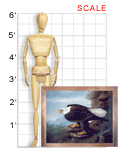VAM galleries including this work:
John James Audubon Museum | Animal Farm || VAM Home
John James Audubon (West Indian-born, American, 1785-1851)
BALD EAGLE, 1828
Oil on canvas; 34" X 43"
John James Audubon Museum
Though John James Audubon preferred to use watercolor and pastel for his bird portraits, he was also an accomplished painter in oils—the favored medium of most art patrons of his day. Thus, Bald Eagle was executed in oil. It is Audubon’s only portrait of a bald eagle in this medium. The work was intended to be traded to English artist John Gould, but the trade was never completed, and the painting was rolled up and sealed inside a tin tube shortly after its completion.
In Audubon’s other renderings of this bird, the viewpoint is higher, allowing the viewer to look down toward the eagle as it is about to dine on a goose or fish. This image shows the eagle alone on a lofty cliffside, with a dramatic backdrop of heavy clouds. The wings are slightly opened, and the bird’s piercing eye glares defiantly into the eyes of the viewer as it prepares to launch itself into the sky. The painting is executed in a much looser style than the very tight work Audubon is best known for. The big, sweeping brushstrokes are not at all typical of his work.
About the Artist
John James Audubon was born in Les Cayes, Santo Domingo (known today as Haiti), on April 26, 1785. Raised in France, he moved to Pennsylvania at the age of 18. In 1808, he married Lucy Blakewell.
Audubon spent 12 years in what was then frontier Kentucky, in Louisville and then Henderson, trying his hand in the business world while sketching and painting birds in his spare time. By 1820, he had given up on business and decided to study and paint birds as a career. He published his monumental book Birds of America, which featured life-size portraits of 1,065 individual birds, in four volumes between 1827 and 1838.
A self-taught artist and naturalist, Audubon was ridiculed by contemporary ornithologists, but his paintings, which depict birds in their natural state, are now renowned and widely celebrated. In 1886, a bird preservation organization adopted the artist’s name, eventually evolving into the National Audubon Society.
Suggested bibliography for grades 4-12:
- Audubon: Life and Art in the American Wilderness by Shirley Streshinsky (Villard, 1993)
- Audubon and His Journals by Maria R. Audubon (Dover, 1994)
- John James Audubon: The Making of an American by Richard Rhodes (Knopf, 2004)
- Audubon’s Birds of America by Roger Tory Peterson and Virginia Peterson (Abbeville Press, 2003)
- Darwin’s Audubon: Science and the Liberal Imagination by Gerald Weissmann (Perseus Books, 2002)
Classroom Ideas
Discussion: Why is the bald eagle significant? Where might you have seen an image of the bald eagle before? Do you think this is an accurate depiction of a bald eagle and where it might be seen? Do you notice a difference between the style of this work and other works by Audubon in the Kentucky Virtual Art Museum? Do you think this painting does a good job of representing the bald eagle’s significance to Americans?
Activities: Research project/science connection: Why was the bald eagle placed on the federal endangered species list? Research the issues surrounding the bald eagle’s plight. What chemical was used in farming that caused eagles to die? When and why was the use of this chemical banned? What is the status of the bald eagle today? Can bald eagles be seen in Kentucky? You might also read Rachel Carson’s book Silent Spring, which examines the use of pesticides in farming and their effects on the ecosystem. This information can be related to a class lesson on science and conservation.
The bald eagle is the national emblem of the United States. It is also important to many Native American peoples. What are the characteristics of a bald eagle that might account for its significance to various cultures? Research various myths and stories related to the bald eagle. Illustrate one of the myths or stories you find, making sure your depiction of the bald eagle illustrates its important characteristics.
Links
Learn more about the bald eagle at BaldEagleInfo.com and the Patuxent Wildlife Research Center site.
[www.baldeagleinfo.com]
[www.mbr-pwrc.usgs.gov/id/framlst/i3520id.html]
For background information about biologist Rachel Carson and her fight to ban DDT, visit Linda Lear’s RachelCarson.org.
[www.rachelcarson.org]
Read a biography of Audubon at the National Audubon Society web site, where you can also flip through an online version of Birds of America.
[www.audubon.org/nas/jja.html]
[www.audubon.org/bird/BoA/BOA_index.html]
Listen to a radio interview with Richard Rhodes, author of John James Audubon: The Making of an American, from New Hampshire Public Radio.
[nhpr.org/view_content/7615/]
The National Gallery of Art includes 36 works by Audubon for viewing online.
[www.nga.gov/cgi-bin/psearch?Request=S&imageset=1&Person=750]
Visit the North Carolina Museum of Art to view another Audubon depiction of the bald eagle.
[www.ncmoa.org/collections/highlights/american/before1850/eagle_lrg.shtml]

